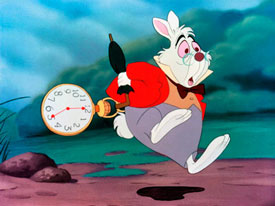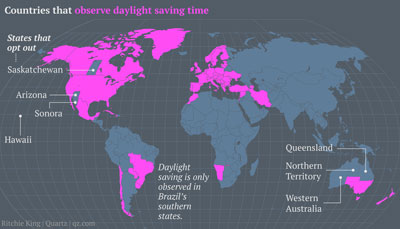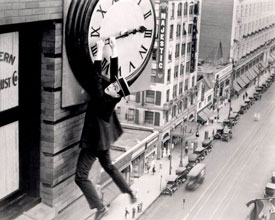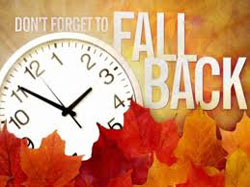 NEW YORK—“I’m late! I’m late, for a very important date!” When you look at the clocks around your house tomorrow, don’t worry, your eyes aren’t playing tricks on you. It’s just that time of the year again—Daylight Saving Time (DST) to be exact.
NEW YORK—“I’m late! I’m late, for a very important date!” When you look at the clocks around your house tomorrow, don’t worry, your eyes aren’t playing tricks on you. It’s just that time of the year again—Daylight Saving Time (DST) to be exact.
This means that on Sunday, Nov. 5 at 2 a.m. it will be time to set our clocks back one hour. Although this time change can be a slight inconvenience—think of it as a biennial time warp. It’s nothing like traveling to the Upside Down, but things can get a little strange. While this time hopping that some of us observe does have its pros and cons, whether you love it or hate it, you can’t deny that DST does have a pretty colorful history of confusing us all.
Let’s take a look at some Daylight Saving Time fun facts as we prepare to “fall back” an hour to give us a better idea of its effects on travel, economics and its potential influence on our health.
First things first, it’s "Daylight Saving Time" (singular), not "Daylight Savings Time" (plural). OK—now that we have that out of the way, let’s find out why some of us even partake in this.
 Who, What, Where, Why started this changing of the clocks?
Who, What, Where, Why started this changing of the clocks?
- Contrary to popular belief, Benjamin Franklin wasn’t exactly the inventor of Daylight Saving Time. He did propose the concept of changing the clocks in a satirical letter to the Journal of Paris in 1784, but it was actually Englishman, William Willett who led the first DST campaign in favor of the UK moving clocks forward 80 minutes between April and October so more people could enjoy the sunlight.
- However, it would be Germany in 1916 who would become the first country to implement DST on a national level.
- But not everyone in the U.S. observes DST. Hawaii and Arizona (except the Navajo Nation) don’t observe DST, and the U.S. territories of American Samoa, Guam, Puerto Rico, the U.S. Virgin Islands and the Northern Mariana Islands keep their clocks on standard time year-round.
- Worldwide, approximately 70 countries, observe Daylight Saving Time.
 What are some of the implications of changing the clocks twice a year?
What are some of the implications of changing the clocks twice a year?
-
Some studies show that DST leads to fewer road accidents due to the longer amount of daylight out while more people use the roadways.
- Other studies claim that the time change negatively impacts people’s health leading to more heart attacks on the Monday following the time change as well as a disruption in people’s sleeping habits.
- As for saving energy, that’s debatable. When it was first introduced, people saved on the amount of artificial light that was needed. But in this modern age of technology with computers, air conditioning and other energy using devices, whether the sun is up or not might not make a difference.
- Chaos of Clocks can ensue:
After national DST was repealed three weeks after World War II ended, a confusing medley of time zones took over as it was up to states and cities to manage their times. “In 1965 there were 23 different pairs of start and end dates in Iowa alone, and St. Paul, Minnesota, even began daylight saving two weeks before its twin city, Minneapolis. Passengers on a 35-mile bus ride from Steubenville, Ohio, to Moundsville, West Virginia, passed through seven time changes.”
 Who benefits from this?
Who benefits from this?
- Recreational facilities from golf courses to garden supply centers and the barbequing sector see a spike when DST begins. "In 1986, when Congress changed DST from six months to seven, the golf industry said the extra month brought in $200 million in additional sales of golf clubs and greens fees. The barbecue industry said the extra month was worth $100 million in sales of grills and charcoal briquettes."
- "For 25 years, candy makers have wanted to get trick-or-treating covered by Daylight Saving, figuring that if children have an extra hour of daylight, they'll collect more candy," Michael Downing, author of Spring Forward: The Annual Madness of Daylight Saving Time, said on NPR."
Tomorrow we’ll gain a much deserved extra hour of sleep, and we’ll now be greeted with shorter days and longer nights to binge watch our favorite Netflix shows of course. But even though our smartphones handle most of the dirty work for us, don’t forget to change the remaining clocks around the house and in the car to avoid mixing up your schedule. You don’t want to be running around like the White Rabbit from Alice in Wonderland this weekend, so remember: It’s spring forward; fall back.